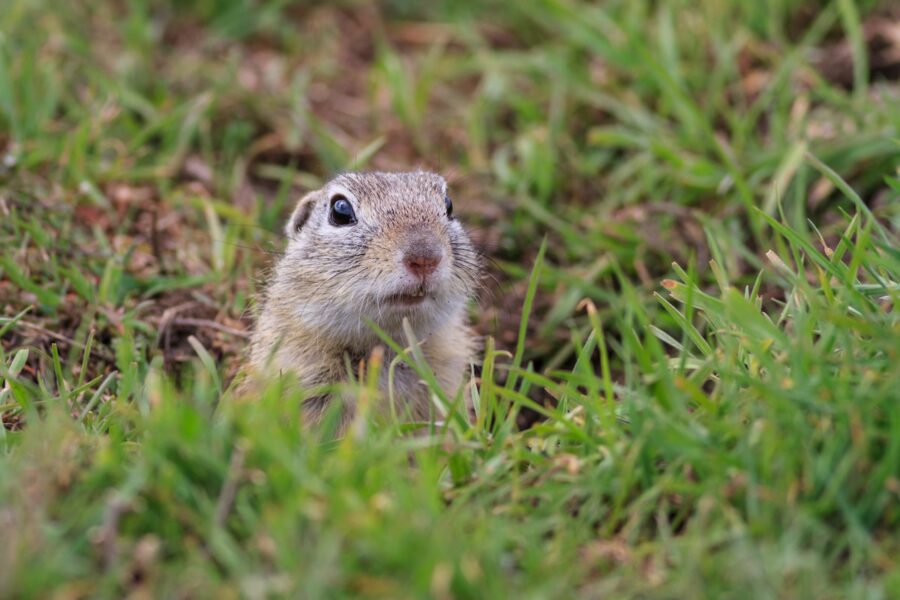Table of Contents
What Are Groundhogs?
Groundhogs, also known as woodchucks, are medium-sized stocky rodents that belongs to the marmots group.
Groundhogs are larger than most rodents, only a little smaller than raccoons. These lowland rodents inhabit much of North America. And while they’re typically wild animals, human encounters aren’t uncommon.
But what’s the nature of interactions between humans and groundhogs? Are groundhogs aggressive towards humans?
Read on to find out.
More About Groundhogs
The groundhog is a squirrel species that’s relatively larger than most rodents. Adult males can grow to around 18 – 20 inches long and measure 13 pounds. These rodents are characterized by their thick brownish fur, razor-sharp incisors, and claws that help them dig underground burrows.
Groundhogs have a reputation for building extensive burrows and defending their real estate viciously against unwelcome guests. Their burrows are similar to those of prairie dogs.
But while groundhogs are mainly underground dwellers who spend much of their time burrowing, these chubby rodents can also swim and climb trees.
Groundhogs are mostly herbivorous. However, they’re occasionally omnivorous and don’t mind snacking on insects, snails, and other smaller animals.
In terms of habitat, groundhogs live throughout North America. The rodents mostly inhabit the eastern hemisphere of the United States, with their population widespread in Alabama, South Carolina, Georgia, Iowa, Missouri, and Minnesota. They also inhabit much of Canada.
Are Groundhogs Aggressive To Humans?

Groundhogs may be relatively larger and somewhat more intimidating than most rodents. But these squirrels are generally not aggressive to humans.
Groundhogs will do their best to avoid crossing paths with humans. And even if they happen to encroach into our territories (or the other way around), woodchucks are unlikely to draw first blood.
That said, it’s still important to watch your back when exploring the outdoors or living in neighborhoods prowled by groundhogs. Certain factors could predispose these otherwise gentle giants to aggression.
Which Scenarios Might Cause A Groundhog To Turn Aggressive?
1. Fear and Anxiety
Groundhogs spend a great deal of their time hiding in their underground burrows. The burrows offer them a sense of safety and comfort.
So, it’s only natural that a groundhog will feel threatened if you or your dog venture uncomfortably closer to their burrows.
2. Wounded Groundhogs
A wounded groundhog will most likely behave defensively if he encounters humans. That’s regardless of how the rodent may have sustained his injuries.
Like any animal, an injured groundhog may feel vulnerable and defenseless. Acting overly aggressive is a proactive way of warding off any potential attacks.
3. Nursing Groundhogs
Animals, both tiny and gigantic, are known to defend their young viciously. And a groundhog is no exception.
If you ever spot a groundhog mum walking directly in your path alongside her young, your best bet is to change course. When maternal instincts kick in, it doesn’t matter your size or how armed you are. A groundhog will most certainly charge at you.
What’s A Groundhog’s Chief Defense Mechanism?

Groundhogs typically bite in self-defense. The rodents have large, razor-sharp incisors that can easily break your skin and inflict deep wounds. Besides leaving you with excruciating pain, groundhog bites can also transmit deadly infections, including rabies, Lyme disease, and Powassan.
Experts recommend attending to the wound immediately. Clean the spot using warm water, then apply a combination of analgesic and antiseptic creams or ointments. That helps to relieve pain and prevent bacterial infections, respectively. Next, bandage the wound using medical gauze to minimize the risks of infection further.
Depending on the nature of the attack, you may also consider seeking professional medical aid.
Can You Keep Groundhogs As Pets?
Groundhogs are incredibly clean animals. These rodents usually dig an extensive network of burrows and designate various tunnels for specific activities. You’ll find tunnels used specifically as latrines and others dedicated to sleeping, raising their young, and hiding from predators.
But despite their reputation for cleanliness, groundhogs neither make excellent pets nor backyard pests. These rodents are more at home in their natural burrows than your basement or backyard.
The main drawback to raising a groundhog as a pet is their razor-sharp incisors that can tear and chomp through anything. On a long enough timeline, a single woodchuck can compromise the structural integrity of your property by gnawing through its foundation.
Besides, groundhogs are generally independent and strong-willed. Therefore, they’re harder to control than most domesticated pets.
How Do You Get Rid Of Groundhogs From Your Property?

Woodchucks will do their best to avoid potential human encounters. But that doesn’t mean our paths won’t cross from time to time.
If you suspect that your property could be harboring groundhogs, do not fret. Call a professional pest removal company immediately.
In addition to engaging a licensed pest remover, the following tips may also help you deal effectively with groundhog infestation:
1. Know When They’re Most Active
Groundhogs will go into hibernation during winter by burrowing in their underground tunnels. The rodents will then emerge in early spring and remain active throughout the warmer months.
2. Know the Signs of Groundhog Presence
There are numerous tell-tale signs of groundhog presence on your property. Examples include:
• Raised ridges crisscrossing your compound
• Raised dirt mounds in your yard
• Multiple areas of loose or squishy soil in your yard
• Patches of discolored grass on your compound
• Damaged tree roots and flower beds
3. Use Bait Traps
You can use baits like fresh grass and plants to lure groundhogs into a trap. However, be sure to use a safe trap that only captures the animal and not one that ends up injuring or killing him. Remember that the idea is to return the rodent back to his natural habitat.
4. Use Deterrents
There’s also the option of using deterrents to flush groundhogs from your property. You can start by dousing your yard in ammonia-, garlic-, or pepper-based sprays.
Smoke has also proven to be an effective groundhog deterrent. Simply light a piece of wood and insert it into one of the groundhog holes.
If it comes down to it, do a perimeter wall or fence around your property to keep these rodents at bay.
5. Vaccinate Your Pets
Humans are smart enough to stay clear of groundhogs. But we cannot say the same about our pets. An encounter between a woodchuck and your dog could easily become bloody.
Fortunately, you can always vaccinate your pets against common diseases spread by groundhogs.
Wrap Up

Groundhogs are naturally unaggressive to humans. However, certain factors may trigger violent confrontations with these rodents.
Staying clear of groundhog burrows is the best way to avoid deadly encounters. You can also explore the above-listed methods to remove these rodents from your property.

